
Erebia pandrose, the dewy ringlet, is a member of the subfamily Satyrinae of the family Nymphalidae. It is found from the Arctic areas of northern Europe, the Pyrenees, Alps, the Apennine Mountains, the Carpathian Mountains, Kola Peninsula and Kanin Peninsula, part of the Ural and the Altai and Sayan Mountains up to Mongolia.

Acraea natalica, the Natal acraea, is a butterfly of the family Nymphalidae, which is native to East and southern Africa.

Acraea anemosa, the broad-bordered acraea, is a butterfly of the family Nymphalidae which is native to southern Africa and coastal East Africa.

Acraea cabira, the yellow-banded acraea, is a butterfly of the family Nymphalidae that is native to Africa.
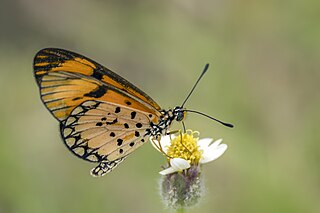
Acraea serena, the dancing acraea, is a butterfly of the family Nymphalidae. It is found throughout Africa south of the Sahara. It is the most common of the Acraea, from Dakar to Fort-Dauphin and from Yemen to the Cape.

Graphium agamedes, the Westwood's white lady, is a butterfly in the family Papilionidae (swallowtails). It is found in Ivory Coast, Ghana, Togo, Benin, Nigeria, Cameroon, the Central African Republic and the Democratic Republic of the Congo. The habitat consists of the forest/savanna transition zone.
Bicyclus sophrosyne, the large velvet bush brown, is a butterfly in the family Nymphalidae. It is found in Nigeria, Cameroon, the Republic of the Congo, the Central African Republic, the Democratic Republic of the Congo, Uganda, Kenya, Tanzania and Zambia.
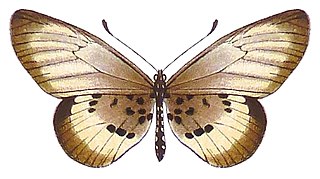
Acraea peneleos, the Peneleos acraea, is a butterfly in the family Nymphalidae, which is native to the tropics and northern subtropics of sub-Saharan Africa.
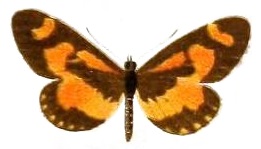
Acraea sotikensis, the Sotik acraea, is a butterfly in the family Nymphalidae which is native to the African tropics and subtropics.
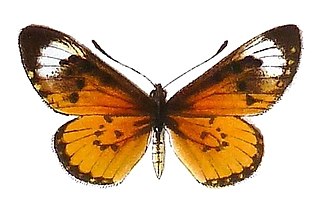
Acraea wigginsi, the Wiggins' acraea, is a butterfly in the family Nymphalidae which is native to tropical Africa.

Acraea parrhasia, the yellow-veined acraea, is a butterfly in the family Nymphalidae which is native to sub-Saharan Africa.

Acraea penelope, the Penelope acraea or Penelope's acraea, is a butterfly in the family Nymphalidae. It is found in Nigeria, Cameroon, the Republic of the Congo, the Democratic Republic of the Congo, Uganda, Kenya and Tanzania. The habitat consists of sub-montane forests.

Euphaedra xypete, the common pink forester, is a butterfly in the family Nymphalidae. It is found in Guinea-Bissau, Guinea, Sierra Leone, Liberia, Ivory Coast, Ghana, Togo, Nigeria and western Cameroon. The habitat consists of forests.
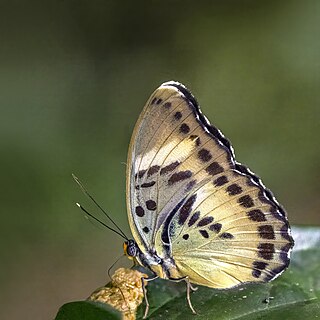
Euphaedra ceres, the Ceres forester, is a butterfly in the family Nymphalidae. It is found in Gambia, Guinea, Sierra Leone, Liberia, Ivory Coast, Ghana, Togo, Benin, Nigeria, Cameroon, Gabon and the Republic of the Congo.
Oboronia albicosta is a butterfly in the family Lycaenidae. It is found in Cameroon, the Democratic Republic of the Congo, Uganda and Zambia. In Seitz it is described - Forewing only at the base feebly dusted with dark, at the distal margin somewhat broader black than pseudopunctatus, more like punctatus. On the hindwing the marginal band is as broad as in punctatus, but the white rings in it are only indistinctly pronounced. Beneath on both wings the black eyespots with white rings are more distinct than in punctatus. On the hindwing all the marginal spots are black, not only that in area 2, which shows blue scales, like in punctatus. The costal margin of the hindwing lacks the spot,and there are only traces noticeable of submarginal yellow lines at the proximal margin and between R 4 and R. 6. Expanse of wings: 30 mm.
Oboronia pseudopunctatus, the light ginger white, is a butterfly in the family Lycaenidae. It is found in Ghana, Togo, Nigeria, Cameroon, Bioko, Gabon, the Republic of the Congo, Angola, the Democratic Republic of the Congo, Uganda and north-western Tanzania. The habitat consists of forests.
Anthene buchholzi is a butterfly in the family Lycaenidae. It is found in Cameroon. In Seitz it is described - he upper surface of the male is of a plain bluish black, that of the female blackish brown with an oviform orange spot at some distance from the posterior margin and posterior angle of the forewing; at the margin of the hindwing there are in the cells 1 and 2 one fine blue streak each, and in cell 2 an orange lunula turned towards it. The under surface is very similar to that of ''L. larydas, but it is remarkably distinguished from it by the costal margin of the forewing being white at the base and the oblique white line beside it, as well as by the two eye-spots at the margin of the hindwing being inwards bordered with orange Forewing 13 to 14 mm. Cameroon, near Victoria. — Although the description is insufficient for ascertaining the species, I am still convinced that it must be identical either with L. lachares or lysicles.This question can only be solved by examining the typical specimen in the Greifswald Museum. Bethune-Baker wrongly translated the description of the and thereby made it unintelligible.

Iridana incredibilis, the incredible sapphire gem, is a butterfly in the family Lycaenidae. It is found in Sierra Leone, Liberia, Ivory Coast, Ghana, southern Nigeria, Cameroon, the Democratic Republic of the Congo and Uganda. The habitat consists of forests.

Boeberia is a genus of satyrine butterflies containing a single species Boeberia parmenio found in the Altai Mountains South Siberia, Mongolia, Yakutia, Amur and Northeast China.

Charaxes borneensis, the White Banded Rajah, is a butterfly in the family Nymphalidae. It was described by Arthur Gardiner Butler in 1869. It is found in the Indomalayan realm.














